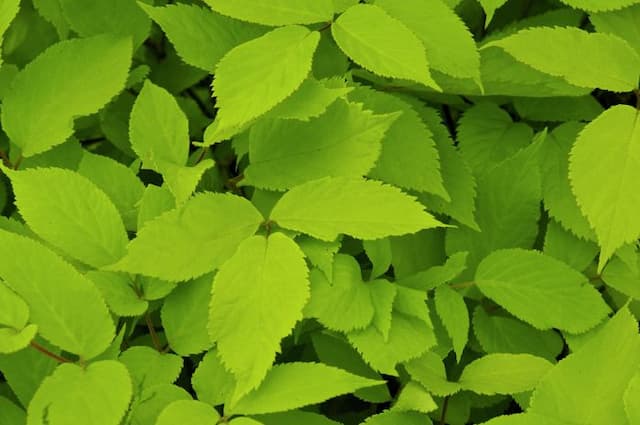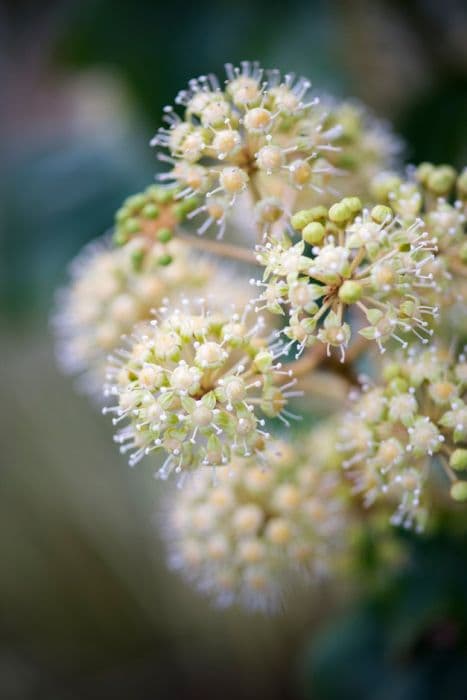English Ivy Hedera helix 'Clotted Cream' (v)

ABOUT
English ivy 'Clotted Cream' is a unique variety distinguished by its attractive foliage. This evergreen vine features leaves that are variegated and can be described as having a creamy-yellow to pale-gold edge with a rich green center. The heart-shaped leaves are glossy and have a slightly puckered texture, which gives them a somewhat ruffled look. These creamy edges can sometimes blend softly into the green, creating a marbled appearance. As a vine, English ivy 'Clotted Cream' will cling and climb on surfaces with its aerial rootlets, which allow it to attach to various structures. When left unclimbed, it can also create a carpet-like ground cover, with stems that spread out horizontally. Its growth pattern and leaf shape can provide a lush, textured effect in the landscape or when grown indoors. The leaves are typically average in size for an English ivy, which adds to its versatility as a decorative plant. It is important to remember that despite its beauty, English ivy 'Clotted Cream' can be quite vigorous, and in some regions, it is considered invasive due to its ability to spread assertively and outcompete native vegetation. Careful consideration should be given to its planting location and the potential need for maintenance to control its growth.
About this plant
 Names
NamesFamily
Araliaceae.
Synonyms
English Ivy, Common Ivy, European Ivy.
Common names
Hedera helix 'Clotted Cream'.
 Toxicity
ToxicityTo humans
English Ivy, which includes the variety Hedera helix 'Clotted Cream,' is considered toxic if ingested. The plant contains compounds such as saponins and polyacetylene compounds that can cause poisoning. Symptoms of English Ivy poisoning may include abdominal pain, vomiting, and diarrhea. In some cases, contact with the sap can also cause skin irritation or allergic reactions upon touching the leaves. If significant quantities of the plant are eaten, it could potentially result in more severe health consequences, such as difficulty in breathing, convulsions, or coma, requiring immediate medical attention.
To pets
English Ivy, the common name for Hedera helix 'Clotted Cream,' is also toxic to pets, including dogs and cats. The toxic principles in this plant can cause symptoms such as vomiting, abdominal pain, hypersalivation, and diarrhea if ingested. Additionally, in severe cases, ingestion can lead to more serious symptoms such as tremors, ataxia, or seizures. It's important to prevent pets from chewing on or ingesting any part of this plant, and to seek veterinary care as soon as possible if poisoning is suspected.
 Characteristics
CharacteristicsLife cycle
Perennials
Foliage type
Evergreen
Color of leaves
Variegated
Height
50 feet (15 meters)
Spread
30 feet (9 meters)
Plant type
Climber
Hardiness zones
5
Native area
Europe
Benefits
 General Benefits
General Benefits- Aesthetic Appeal: Hedera helix 'Clotted Cream,' commonly known as English Ivy, adds visual interest to gardens with its variegated, creamy-yellow leaves.
- Versatility: It is suitable for various gardening applications including ground cover, wall climbing, or container gardening.
- Ease of Care: English Ivy is relatively low-maintenance, tolerating a range of light conditions and surviving with minimal care.
- Rapid Growth: It grows quickly, providing fast coverage for garden spaces or structures.
- Erosion Control: With its dense growth habit, it can help prevent soil erosion on slopes and banks.
- Wildlife Support: It offers shelter and food for birds and beneficial insects within the garden ecosystem.
- Adaptability: English Ivy can adapt to various soil conditions, although it prefers fertile, humus-rich soils.
- Evergreen: As an evergreen plant, it provides year-round greenery and structure in the garden.
 Medical Properties
Medical Properties- This plant is not used for medical purposes.
 Air-purifying Qualities
Air-purifying QualitiesThis plant is not specifically known for air purifying qualities.
 Other Uses
Other Uses- Ivy 'Clotted Cream' can be used as a natural dye, providing varying shades of green and yellow depending on the mordant used.
- The vines of Ivy can be woven into decorative wreaths and other forms of greenery for festive decorations during holidays and celebrations.
- In photography and film, Ivy is often employed to give scenes a lush, and sometimes, an aged or abandoned appearance.
- Ivy is commonly used in topiary, as it can be shaped and trained over frames to form various living sculptures.
- Crafters might use the leaves of Ivy 'Clotted Cream' to create eco-friendly, biodegradable confetti.
- The plant can be used in constructing insect hotels, providing shelter and climbing structures for beneficial garden insects.
- Ivy tendrils are sometimes incorporated into natural jewelry, either as the main feature or as an adornment.
- In landscaping, Ivy can be applied as erosion control on slopes due to its dense growth habit and strong root system.
- The extensive root system and evergreen nature of Ivy make it suitable for creating living curtains or green screens for privacy.
- Ivy can be used in themed gardens, such as fairy or fantasy gardens, to create a whimsical environment with its trailing vines.
Interesting Facts
 Feng Shui
Feng ShuiThe English Ivy is not used in Feng Shui practice.
 Zodiac Sign Compitability
Zodiac Sign CompitabilityThe English Ivy is not used in astrology practice.
 Plant Symbolism
Plant Symbolism- Friendship: Often given as a gift to signify enduring friendship, as ivy can grow and thrive in different conditions, symbolizing the resilience and lasting nature of a solid friendship.
- Fidelity: Ivy represents faithfulness and eternal loyalty, reflecting the plant's ability to cling and stay attached to surfaces, much like a devoted partner in a relationship.
- Protection: Historically, ivy was believed to ward off evil spirits. People would plant ivy around their homes as a form of natural protection and good luck.
- Eternal life: The evergreen nature of ivy signifies immortality and eternal life, an emblem of the soul's ongoing journey beyond physical existence.
- Marriage: Ivy is commonly associated with weddings, symbolizing the strong, interwoven relationship between the betrothed couple and their desire for a lasting union.
 Water
WaterEnglish Ivy prefers to be watered when the top inch of the soil feels dry to the touch, which typically means once every 5 to 7 days, depending on the humidity and temperature conditions. When watering, thoroughly soak the soil until water runs out of the drainage holes, which might be around a half to one gallon for a medium-sized pot. Always allow the excess water to drain away, as standing water can lead to root rot. During the winter months or in lower light conditions, reduce the frequency of watering to prevent soggy soil.
 Light
LightEnglish Ivy thrives in bright, indirect light but can also tolerate low light conditions. The ideal spot for English Ivy would be near a north- or east-facing window where it receives plenty of light without direct sun exposure. Harsh afternoon sunlight can scorch the leaves, so it’s best to avoid placing the plant in direct, unfiltered sunlight.
 Temperature
TemperatureEnglish Ivy prefers a temperate range of 50 to 70 degrees Fahrenheit, though it can handle temperatures as low as 30 degrees for short periods without severe damage. Avoid extreme temperature fluctuations and keep the plant away from drafts and heat sources such as radiators to maintain a consistent environment. The ideal temperature conditions would be around 60 to 65 degrees for healthy growth.
 Pruning
PruningPruning English Ivy is essential for maintaining its shape, encouraging fuller growth, and removing any damaged or diseased foliage. It is best to prune the plant in the early spring before new growth begins. Pruning can be done as often as needed to control the plant’s size but should at least be done annually. Use sharp, clean shears to make precise cuts, which will help prevent infection.
 Cleaning
CleaningAs needed
 Soil
SoilEnglish Ivy 'Clotted Cream' thrives in well-draining soil rich in organic matter with a pH of 5.5 to 6.5. A mix of two parts peat, one part perlite, and one part compost is ideal for providing the necessary drainage and nutrients.
 Repotting
RepottingEnglish Ivy 'Clotted Cream' should be repotted every two to three years to refresh the soil and accommodate root growth, ensuring the plant remains healthy and vigorous.
 Humidity & Misting
Humidity & MistingEnglish Ivy 'Clotted Cream' prefers moderate to high humidity levels, ideally between 40% to 70% for optimal growth without encouraging leaf issues.
 Suitable locations
Suitable locationsIndoor
Place in bright, indirect light and maintain moderate humidity.
Outdoor
Provide shade, water regularly, and protect from harsh sun.
Hardiness zone
5-11 USDA
 Life cycle
Life cycleThe English ivy 'Clotted Cream' begins its life as a seed, which upon germination develops into a juvenile plant with lobed leaves and a trailing growth habit. This stage can last for several years as the plant spreads horizontally or climbs vertically using aerial rootlets. As it matures, the plant enters the adult stage characterized by unlobed leaves and the production of small, yellow-green flowers in late summer to fall, which are more common when the ivy is allowed to grow vertically and exposed to more light. Following pollination, typically by insects, the flowers develop into small, dark blue or blackberries that are dispersed by birds, facilitating the spread of the plant. Under favorable conditions, this evergreen perennial can become an aggressive grower, covering large areas and outcompeting other plants. After many years, English ivy may become woody and tree-like in its mature form.
 Propogation
PropogationPropogation time
Spring-Early Summer
The most common method for propagating English ivy, including the 'Clotted Cream' variety, is through stem cuttings. This is typically done in spring or early summer when plant growth is most active. To propagate, a gardener would select a healthy stem with several leaves and cut it to a length of about 4 to 6 inches (10 to 15 centimeters) using a clean, sharp pair of scissors or pruning shears. The lower leaves are removed, and the cutting is placed either directly into moist soil or water to encourage root development. The use of a rooting hormone can enhance the chances of successful rooting. The cuttings should be kept in a warm environment with indirect light until new roots have formed, after which they can be transplanted to their permanent location.









